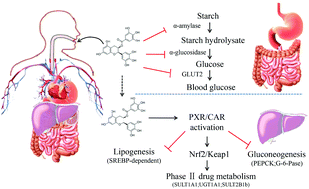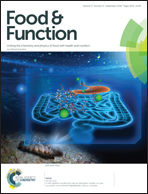(−)-Epigallocatechin-3-gallate (EGCG) inhibits starch digestion and improves glucose homeostasis through direct or indirect activation of PXR/CAR-mediated phase II metabolism in diabetic mice†
Abstract
As a major component of green tea, (−)-epigallocatechin-3-gallate (EGCG) has attracted interest from scientists owing to its potential to combat a variety of human diseases including abnormal glucose metabolism in obesity and diabetes. This study aims to (1) evaluate the molecular mechanism of EGCG in starch digestion before EGCG absorption; (2) investigate the link between PXR/CAR-mediated phase II metabolism and glucose homeostasis after EGCG is transported to small intestine and liver. EGCG suppressed starch hydrolysis both in vitro and in vivo. Molecular simulation results demonstrated that EGCG could bind to the active site of α-amylase and α-glucosidase, acting as an inhibitor. In addition, the anti-diabetic action of EGCG was investigated in high fat diet and STZ-induced type 2 diabetes. EGCG improved glucose homeostasis and inhibited the process of gluconeogenesis (PEPCK and G-6-Pase) and lipogenesis (SREBP-1C, FAS and ACC1) in the liver. Meanwhile, EGCG treatment activated PXR/CAR, accompanied by upgrading PXR/CAR-mediated phase II drug metabolism enzyme expression in small intestine and liver, involving SULT1A1, UGT1A1 and SULT2B1b. Dietary polyphenol EGCG could serve as a promising PXR/CAR activator and therapeutic intervention in diabetes.



 Please wait while we load your content...
Please wait while we load your content...